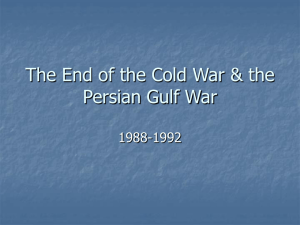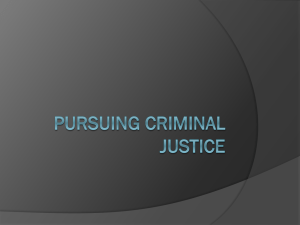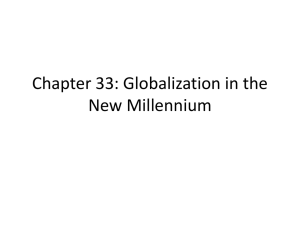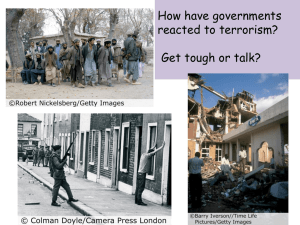THE SENATE ARMED SERVICES COMMITTEE STATEMENT OF GENERAL TOMMY R. FRANKS FORMER COMMANDER
advertisement
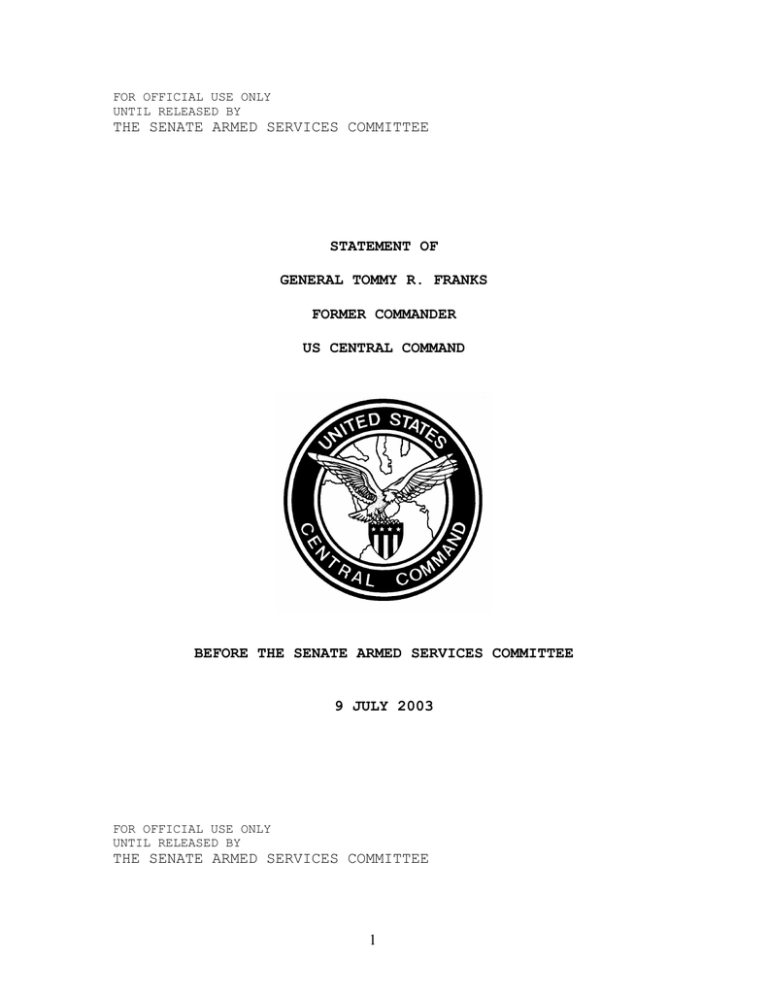
FOR OFFICIAL USE ONLY UNTIL RELEASED BY THE SENATE ARMED SERVICES COMMITTEE STATEMENT OF GENERAL TOMMY R. FRANKS FORMER COMMANDER US CENTRAL COMMAND BEFORE THE SENATE ARMED SERVICES COMMITTEE 9 JULY 2003 FOR OFFICIAL USE ONLY UNTIL RELEASED BY THE SENATE ARMED SERVICES COMMITTEE 1 Mr. Chairman and members of the Committee, I am honored to appear before you today. Since we last met here together, much has taken place in the Central Command area of responsibility. We have removed a brutal regime in Iraq and have begun to help Iraq build its new future. Our forces have continued to help Afghanistan make strides towards independence, and have continued to help the Afghan people develop their nation while continuing to seek and destroy terrorists and their networks all across the Central region. I look forward to discussing these important subjects with you and to your questions. Let me begin by bringing you a message from the more than 281,000 US and Coalition troops that I have been privileged to command. message is thank you. That Throughout both Operation Iraqi Freedom and Operation Enduring Freedom, our forces in the field have been blessed to serve civilian leaders who set clear military objectives and then provide our men and women in uniform the tools they need to win. On their behalf, let me thank you for all that you continue to do for the troops. As you know, earlier this week General John Abizaid took the reins of command at CENTCOM. He is a principled leader and soldier who has been tested under fire, and I am confident about the future of CENTCOM under his leadership. I would like to begin today by recognizing the Coalition nations whose contributions of forces, equipment, and economic support have signaled a worldwide commitment to eradicate terrorism. Over the past twelve months, the Coalition has been steadfast. Today there are 63 nations represented at Central Command’s Tampa headquarters. 2 We have built a force in the CENTCOM Area of Responsibility (AOR) to help achieve our objectives in Operation Iraqi Freedom and Operation Enduring Freedom--to deny terrorists the use of weapons of mass destruction (WMD), and to bring terrorists to justice and dismantle their terrorist networks. We have also established a more visible and viable presence in the Horn of Africa (HOA) in order to combat terrorism and promote stability. Work in the Central Region is underway, but as I will discuss in the sections ahead, the environment within the region remains challenging. Securing US interests and ensuring regional stability will involve risks and will require continuing commitment of resources. USCENTCOM Area of Responsibility (AOR) Our AOR encompasses 6.4 million square miles, from Egypt and Jordan to the Horn of Africa, the Arabian Peninsula, Pakistan in South Asia, and the Central Asian states as far north as Kazakhstan. It includes the waters of the Red Sea, the Northern Indian Ocean, the Persian Gulf, and the key maritime choke points of the Suez Canal, the Bab el Mandeb, and the Strait of Hormuz. The area is home to more than 500 million people, representatives of all the world's major religions and at least 18 major ethnic groups. National economies produce annual per capita incomes varying from a few hundred dollars to tens of thousands of dollars. CENTCOM’s AOR includes dictatorships, absolute monarchies, failed states, democracies and governments in transition toward democracy. Humanitarian crises, resource depletion and overuse, religious and ethnic conflicts, demographic challenges and military power imbalances that generate social, economic, and military 3 volatility characterize this area. These factors are particularly significant given the geographical and economic importance of the region where natural resources provide extraordinary economic opportunities. However, they also give rise to a range of socioeconomic problems and rivalries. Some states have compensated for their lack of mineral wealth through the industry of their people. However, other nations have not generated the will, resources or organization to move ahead. These factors will not be easily or quickly overcome and signal additional challenges in the future. In the past two years, USCENTCOM has been at the leading edge of the Global War on Terrorism (GWOT). The Command is engaged with U.S. and coalition forces both in Afghanistan and Iraq. Our commitment remains strong as our leaders and troopers work to bring security throughout the region. On the ground in Iraq today, our troops are conducting ongoing operations, combining Civil Military Operations with direct military action to seek out and bring to justice leaders of the fallen regime. Our priorities include forming and training police, security forces, and the New Iraqi Army; improving the infrastructure; supporting the establishment of local government and providing emergency medical care and other humanitarian assistance. Much dangerous work remains to be done, but millions of Iraqis have freedoms today which four months ago were only a dream. Our troops are working closely with Ambassador Jerry Bremer and his civilian team to provide the tools he needs to be successful. 4 Progress is being made, and our country is justifiably proud of all that has been accomplished. OPERATION IRAQI FREEDOM - LESSONS LEARNED Decisive combat in Iraq saw a maturing of joint force operations in many ways. Some capabilities reached new performance levels. From a Joint Integration perspective, our experience in OPERATIONS Southern and Northern Watch, and Enduring Freedom helped to develop a joint culture in our headquarters and in our components. These operations helped to improve joint interoperability and improve our joint C4I networks as joint force synergy was taken to new levels of sophistication. Our forces were able to achieve their operational objectives by integrating ground maneuver, special operations, precision lethal fires and non-lethal effects. We saw for the first time integration of forces rather than deconfliction of forces. This integration enabled conventional (air, ground, and sea) forces to leverage SOF capabilities to deal effectively with asymmetric threats and enable precision targeting simultaneously in the same battle space. Likewise, Special Operators were able to use conventional forces to enhance and enable special missions. Operational fires spearheaded our ground maneuver, as our forces sustained the momentum of the offense while defeating enemy formations in open, complex, and urban terrain. We saw jointness, precision munitions, C2, equipment readiness, state of training of the troops, and Coalition support as clear "winners" during OIF. 5 That said, we also identified a number of areas which require additional work. Fratricide prevention suffered from a lack of standardized combat identification. Units in theater arrived with seven different combat ID systems, and our commanders were forced to overcome these shortcomings “on the fly”. Deployment planning and execution were cumbersome, and need to be improved to meet the operational demands of the 21st Century. And, Coalition information sharing must be improved at all levels. Finally, human intelligence and communications bandwidth are also areas which will require continuing focus. OPERATION ENDURING FREEDOM - LESSONS LEARNED In Afghanistan, Coalition forces continue to deny anti-coalition elements sanctuary while disrupting their ability to plan, target, rehearse and execute operations. This is accomplished through active combat patrolling from secure fire bases and forward operating bases (FOB) in order to promote stability, enhance the legitimacy of the Interim Transitional Government of Afghanistan (ITGA), and prevent the re-emergence of terrorism. During OEF, we saw a number of functional areas and capabilities that reached new levels of performance. In some areas, improvements were made prior to Operation Iraqi Freedom. For example the DoD/CIA synergy which worked well during OEF was built upon the integration of liaison officers in each of our headquarters which facilitated teamwork and paid great dividends in Iraq. 6 Also, we continued to leverage coalition strengths as new Coalition members were added. “The mission determines the Coalition; the Coalition does not determine the mission.” Advanced technologies employed during OEF were also critical. The command and control of air, ground, naval, and SOF from 7,000 miles away was a unique experience in warfare as our forces achieved unprecedented real time situational awareness and C2 connectivity. We learned that precision-guided munitions represent a force multiplier. Low collateral damage during both OEF and OIF was a fundamental factor in achieving our objectives. Early in OEF we saw the need for an unmanned sensor-to-shooter capability to support time-sensitive targeting (TST). The armed Predator demonstrates great potential and will be a high payoff system in the future. Blue Force Tracking and enhanced C4I systems increase lethality and decrease response time, and also represent transformational technologies. We will continue with development of Global Hawk as an unmanned, high-altitude, long loiter time, beyond line-of-sight multi-sensor UAV, and will work to incorporate laser designation and delivery of precision weaponry from that platform. The integrated common operating picture (COP) was a very powerful tool. Tracking systems were previously Service unique. Workarounds were developed for OIF, but there is a need to develop one integrated, user-friendly, C4I architecture that captures blue and red air, ground and maritime forces. Strategic lift and tanker aircraft availability were stretched during OEF and OIF. These forces are critical to rapid future force 7 projection and we must enhance this vital capability in the years ahead. Combined and joint training of our forces was also a key factor during OEF and was carried over into OIF. Our military forces are the best-prepared forces in the world and I thank the members of Congress for providing assets and funding to train these wonderful fighting men and women to give them every possible advantage. Finally, our ability to take action in OEF was predicated on “Strategic Anchors,” one of which was “Cooperative Security” relationships, which paid high dividends in basing, staging and over flight rights during recent crisis. Regional Concerns Iraq Although security continues to improve, portions of Iraq are now, and will remain for some time, dangerous. The term “stability operations” does not infer that combat actions have ended. Military forces are still required to set conditions that enable progress. As we move forward, the composition and size of our forces will change to match emerging requirements. Factors that influence our force mix will include Coalition force contributions, threat, and success in fielding Iraqi police forces, security, and the New Iraqi Army. Integration of Coalition forces is a major near-term effort. United Kingdom and Poland are committed to leading Divisions in Southern Iraq, and many partner nations have offered forces to fill 8 The those units. Deployment of those forces has already begun. discussions with India and Pakistan. We continue At this moment, 19 Coalition partners are on the ground in support of military operations in Iraq, with deployment pending for 19 additional countries. An additional 11 nations are conducting military to military discussions with respect to possibly deploying forces to Iraq in support of stability and security operations. At this point some 35,000 police have been hired. about half of the requirement nationwide. This fills Throughout the country, many of these law enforcement officers are conducting joint patrols with U.S. military forces, and we will ultimately transition responsibility for security and stability to the Iraqis. In the near-term, we must build upon the momentum we have generated in this area. Creation of the New Iraqi Army is moving forward. The plan envisions three divisions located near Mosul, Baghdad, and Basrah to provide territorial defense and conduct stability operations. In the first year, the goal is to field approximately nine battalions. Initially, Iraqi forces will focus on performing security functions at fixed sites, convoy security, and border control. As it develops, this force will work with Coalition forces to contribute to stability and security throughout Iraq. Underlying all security functions is the need to continue humanitarian assistance and the conduct of civil-military operations to improve the quality of life for the Iraqi people. regional allies have been invaluable. In this regard, our Neighboring nations have provided hospitals, medical supplies, water, food, and expertise in 9 beginning the rebuilding process. The fact that there has been no humanitarian disaster in Iraq; no widespread outbreak of disease, hunger, refugees or displaced persons; or any of the other predicted consequences of war is due, in large part, to the generosity of our allies. The CPA and Coalition forces will continue to work in concert with international and non-governmental agencies to reverse the result of years of neglect by a brutal regime. Afghanistan Our efforts in Afghanistan have given the Afghan people a chance to break the chain of violence, civil war, and poverty that many have endured their entire lives. Our Coalition has made considerable progress over the last 18 months, but much remains to be done. The average Afghan now enjoys basic freedoms, a higher quality of life, and prospects for a better future. A Loya Jirga to ratify a new Constitution will be held this fall and national elections are scheduled for next summer. President Karzai’s transitional government continues to develop as he works to expand its authority beyond Kabul. Security and stability are the keys to President Karzai’s success. Since 1 May, our primary focus has shifted to stability operations. stable and secure environment enables reconstruction. A U.S. Civil- Military Operations forces have completed more than 150 projects and nearly 300 more are underway. To date, these projects have improved drinking water, medical care, transportation, communications, irrigation, and agriculture throughout the country. To further our reconstruction efforts and to help foster stability, Provincial Reconstruction Teams (PRT) are working in Bamian, Konduz, and Gardez. 10 A fourth U.K. led team will soon deploy to Mazar-e-Sharif, and other PRTs are being planned for future deployments to additional provinces. A critical step toward stability in Afghanistan is building the Afghanistan National Army (ANA). The U.S. is leading this effort, supported by five Coalition partners. To date, three brigades of professional Afghan soldiers have been fielded; we project ANA strength of approximately 8,500 soldiers by Dec 03. Horn of Africa Several countries in the Horn of Africa responded positively to President Bush's call for support against worldwide terrorism. However, these states are challenged to conduct successful antiterrorism campaigns. Over 21 million people remain at risk of starvation in the region. Long-term conflicts have intensified the debilitating effects of natural disasters, especially drought. This forces the dislocation of affected populations seeking food, medical care, and safety. Existing governments find difficulty meeting the needs of their populations, creating an environment hospitable to terrorist cells and trans-national threats. USCENTCOM has addressed these issues by standing up a Combined Joint Task Force in Djibouti. This Task Force provides a forward presence; trains counter-terrorism forces; and supervises a number of humanitarian assistance efforts to enhance security, improve public health and combat famine. These initiatives are key elements of our Security Cooperation strategy. Close cooperation with interagency and 11 international aid organizations facilitates a regional approach to the humanitarian effort and maximizes the effects of our efforts. The Horn will require a long-term commitment of resources to achieve stability, thereby setting conditions that will make it less hospitable to terrorists. Iran Iran has long pursued a goal of regional hegemony through modernization of a regionally capable military force, the development of weapons of mass destruction (WMD), and the use and promotion of terrorism as an instrument of foreign policy. Tehran perceives itself encircled by the U.S. The enmity and abiding mistrust of the U.S. government is implacable among Iran’s ruling hard-liners furthering security concerns. Iran’s principal security objectives remain unaltered with the fall of Baghdad, namely the survival of the Islamic state and the preservation of Iranian independence, with the secondary goal of expanding Iranian influence in the Persian Gulf, Central Asia, and the broader Islamic world. Iran’s national security policies appear focused on maintaining political stability and internal security, expanding diplomatic and economic relations, establishing WMD and long-range missile forces backed up by unconventional warfare capabilities and maintaining a robust terrorism apparatus. Shifts in regional security relationships are expected as a result of the formation of a stable and productive post-war Iraq. 12 Of course, those realignments and perturbations extend beyond Iraq's borders and will be of concern to Iran. Following the ouster of the Saddam regime in Iraq, Iran has mounted an increasingly sophisticated and multi-faceted influence campaign that will prove persistent in its focus to create an anti-Coalition, predominantly anti- U.S., sentiment among Iraqis. Just as complex is deciphering Iran’s dual-track foreign policy and often contradictory public statements. Iran’s efforts to promote itself as a responsible member nation of the international community are in direct contrast with its long-standing covert and public support to radical resistance groups and terrorists as well as its failure to meet its Nuclear Nonproliferation Treaty (NPT) and International Atomic Energy Agency (IAEA) obligations. The Iranian regime’s proclivity for violence through terrorism, in concert with its past support of terrorism and an established pattern of developing nuclear and other WMD and missile programs, will continue to be of concern. Gulf States Transnational terrorists remain throughout the Gulf region. Violent, anti-Western ideology appeals to some segments of the populace, due in part to the increasing failure of regional governments to meet the basic needs of the people. As populations increase, regional governments struggle to provide adequate education, housing, infrastructure, and jobs. Closed political systems are only just beginning to reform. Regional politics and long-standing, hard-line 13 stances concerning the Palestinian-Israeli situation exacerbate regional instability. However, there are also hopeful signs. Many of the Gulf countries are moving toward a more representational government. Bahrain and Qatar have begun municipal elections; Oman continues working toward opening its economy and political system; and Saudi Arabia has begun efforts to change the educational system, privatize state industries, and open a domestic dialogue on other needed social reforms. Substantive improvements will require a long-term, determined effort. The Gulf States have stepped up their antiterrorism efforts in response to 9/11 and the May attacks in Saudi Arabia. On-going efforts include increasing law enforcement, stemming the flow of illegal financial support, tracking personnel movements, and monitoring terrorist activities. While their cooperation is extensive, these governments continue to prefer working behind the scenes. Militarily, the Gulf States continue to perceive a long-term threat from Iran. In a show of support for Operation IRAQI FREEDOM (OIF), the Gulf States, for the first time, deployed the Peninsula Shield force in defense of Kuwait. Outstanding OIF basing and access support from the Gulf States demonstrates tangible results of our active security cooperation programs. They understand that our "footprint" in the region is likely to change, and each state continues to advocate security cooperation with the U.S. While most citizens are relieved that the Iraqi regime has been removed, opinions differ on Coalition activities and what type of 14 Iraqi society will eventually emerge. Regional governments are looking to the CPA to ensure Iraq does not become segmented. Gulf leaders look forward to lucrative trade and economic relations with a rebuilt Iraq. South and Central Asia Pakistan’s support has been fundamental to our success in Operation ENDURING FREEDOM. President Musharraf has committed substantial national resources against terrorism to include arresting a number of Al Qaida leaders, freezing the financial accounts of known terrorists and banning fundraising to support Kashmiri militancy. He has pursued these actions despite ongoing tensions with India and significant domestic pressure, and he continues on a path toward democracy and sustained economic development. The US has expressed gratitude and solidified his political position by lifting sanctions and granting economic assistance. CENTCOM will continue to support our mil-to-mil relationship and build closer security cooperation with Pakistan. The Central Asian States remain dedicated partners in the Global War on Terrorism. Each country declared its support for the US immediately after the attacks of 9/11. personnel and equipment. All offered to host U.S. Bases established in the Central Asian States have been critical to the success of our operations in Afghanistan. The defeat of the Taliban and the removal of Al Qaida from Afghanistan have enabled the Central Asian States to refocus their attention on internal development. We will continue working with our Central Asian partners to prevent the resurgence of terrorism, and the Department of State and the Bureau of Customs and Border Protection will continue to 15 improve their capacity to secure their borders against the flow of illegal narcotics. WMD Proliferation The proliferation of technologies related to weapons of mass destruction (WMD) and long-range delivery systems continues to be a significant concern in the Central Region. As some nations and international extremist groups pursue chemical, biological, radiological, and nuclear capabilities, some regional allies will seek to offset such threats by pursuing strategic weapons of their own, thus perpetuating the proliferation cycle. Security cooperation is our best hedge against this possibility. Iran continues to pursue WMD. Its nuclear programs are under the continuing scrutiny of the International Atomic Energy Agency, and its chemical weapons stockpile and probable biological weapons program are of concern. In South Asia, the missile and nuclear race between Pakistan and India is also troubling. Both states continue to develop advanced missiles and the risk of miscalculation leading to escalation remains of concern. We face a severe threat in the potential for chemical, biological, radiological or, less likely, nuclear attacks by terrorists. Documents found (during the exploitation of suspect WMD sites in Afghanistan) indicated the al-Qaida terrorist network had explored methods for producing toxins and was seeking to establish a 16 biological warfare capability. Terrorists will continue to seek WMD capabilities as their need for more sensational attacks intensifies. The extensive press coverage of the October 2001 anthrax mail attacks highlighted U.S. vulnerabilities and exacerbated an already dangerous situation in the Central Region, where many extremists are based and exploring such capabilities. Terrorism and Counterterrorism Over the past year, the Global War on Terrorism has been marked by major achievements. Multiple terrorist operations sponsored by al- Qaida and affiliated extremists have been disrupted; and many terrorists, including high-ranking operational planners, have been captured. Al-Qaida has proven unable to reestablish the extensive training infrastructure it had earlier instituted in Afghanistan. The dispersal of its leaders and cadre from Afghanistan continues to impede al-Qaida’s ability to accomplish timely and secure communications exchanges. Nevertheless, al-Qaida has responded to our counter-terrorism initiatives; in this context, several lesser-known personalities have emerged and this has translated into strikes such as the May 2003 bombings of multiple housing complexes in Riyadh. So far, these attacks have focused on “soft” targets; however, al-Qaida retains an interest in striking larger, more spectacular targets. Counterterrorism operations against al-Qaida, U.S. victories in Iraq and Afghanistan, and the persistent conflict between Israel and the Palestinians have generated pressure throughout the USCENTCOM AOR. 17 Jihadist groups and disgruntled individuals constitute another important source of potential terrorist threats. Given this setting, we are constantly working to identify vulnerabilities and refine our force protection measures. Security Cooperation Overview Our success in gaining basing, staging and over-flight rights for ENDURING FREEDOM and IRAQI FREEDOM and our influence in the region are directly related to an active security cooperation program. USCENTCOM’s program builds relationships that promote U.S. interests, build allied and friendly nations’ military capabilities, and provide U.S. forces with access and en route infrastructure. Prosecution of the GWOT requires continued fiscal and political investment in these vital programs. I would like to highlight a few dividends of our approach. The FY03 supplemental appropriation of $908M in FMF is currently enabling the training of a professional Afghan National Army and allowing Pakistan to restore its military forces. Additionally, long- standing partners such as Jordan are increasing their interoperability through FMF-funded purchases. Continued investment in security assistance allows USCENTCOM to improve the capabilities of friendly nations by enabling them to provide for their own security. International Military Education and Training (IMET) remains a low-cost, high-pay off investment that helps shape the security environment. Courses offered under IMET provide military members of 18 regional states an opportunity to attend courses in U.S. military institutions such as Command and Staff Colleges and Senior Service Schools. IMET participation by students from the Central Region supports Congressionally-mandated initiatives: providing exposure to the U.S. concepts of military professionalism, respect for human rights, and subordination to civilian authority. The Counter Terrorism Fellowship, a new DoD appropriation, enables us to provide flexible course offerings to several nations who are key partners in the GWOT. Conclusion The Global War on Terrorism is underway. The precision, determination, and expertise of our military forces and our Coalition partners brought about the liberation of Afghanistan and Iraq in lightning speed with minimum bloodshed. However, these two nations have only taken only the first steps toward freedom, and United States and our Coalition partners must be there to support the whole journey. While we have accomplished much, the potential for terrorist acts and other setbacks remains very real. Afghanistan has a new government, a new army, and with Coalition support the nation is making great strides towards long term stability. In Iraq, Saddam Hussein’s regime was destroyed and regime supporters are being rooted out. Our focus has changed from military destruction of a regime to providing security and humanitarian assistance to the Iraqi people, while helping to establish a representative form of Government. Decisive combat operations have been completed, but much work remains. 19 I am very proud of each and every one of the men and women who continue to serve selflessly and tirelessly in the execution of our mission from Egypt to Kazakhstan, from the Suez to Pakistan, regardless of the uniform of service they wear or the nation from which they come. I thank the Congress and the American people for the tremendous support you have given them. I would be pleased to take your questions. 20

